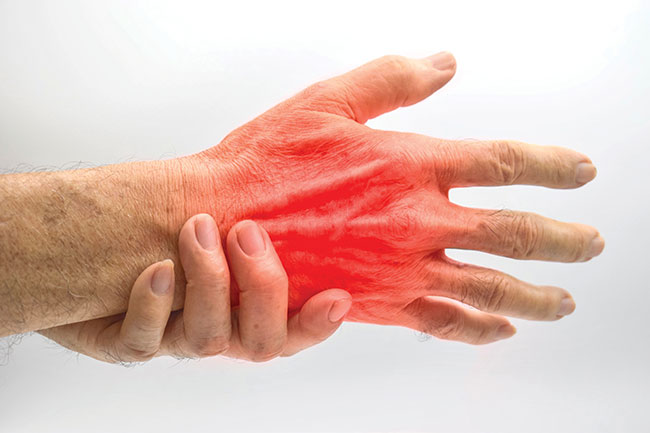
Features
Health & Safety
Health & Safety: The importance of reducing painful tendon disorders
April 27, 2023 By Canadian Centre for Occupational Health and Safety (CCOHS)
 Doing tasks that are repetitive can tear tendon fibres apart
Photo: © ZayNyi/Adobe Stock
Doing tasks that are repetitive can tear tendon fibres apart
Photo: © ZayNyi/Adobe Stock Just as a well-oiled machine functions better than a rusty one, our bodies need smooth, healthy tendons to move freely and without friction. Tendons are rope-like bundles or bands of strong, smooth, shiny fibres that attach muscles to bones to enable the joints to move easily.
Some conditions in the workplace put workers at risk of developing tendon disorders or tendinopathies. These disorders result in the tendons not functioning normally. If you have pain in areas over a tendon or it is tender to the touch, swollen, or red and you feel the movement is restricted, you may have tendinitis or tenosynovitis.
Tendinitis
Tendinitis (also commonly called tendonitis) describes a condition in which the tendons become inflamed or irritated. It can occur anywhere in the body but is most common in the shoulders, elbows, knees, and hands. Doing tasks that are repetitive or for a long period of time, or that involve awkward or stationary postures, vibration, and localized mechanical stress, can tear tendon fibres apart like the way a rope becomes frayed. Tendons that are injured can become thickened, bumpy, and irregular over time, and if they are not given the time and rest needed to heal, can become permanently weakened.
Jobs that require repeated or forceful movements of the fingers, wrist and forearm can cause tendinitis of the elbow, also known as “tennis elbow.” Tendinitis of the elbow is often associated with simultaneous rotation of the forearm and bending of the wrist, stressful gripping of objects with inward or outward movement of the forearm, or jerky, throwing motions – as is often seen in tennis players, but can also occur in the workplace, especially among those who work in landscaping, gardening, or woodworking.
Tenosynovitis
Tenosynovitis is an inflammation of the tendon sheath. The sheath produces a fluid that keeps the tendon lubricated. However, prolonged activities, forceful exertion, awkward and static posture, vibration, and localized mechanical stress can cause the lubrication system to not work properly. The sheath either fails to produce enough fluid or produces fluid with poor lubricating qualities. This creates friction between the tendon and its sheath and results in inflammation, swelling and other problems. Tenosynovitis occurs in the palm side of the wrist and hand, and in the back of the hand and wrist.
Treatment of tendon disorders
Tendon disorders rarely require surgery. Treatment usually consists of staying away from activities that cause or aggravate the disorders, or pain relief through non-steroidal anti-inflammatory drugs, ice or heat, friction massage, stretching and strengthening exercises, transcutaneous (through the skin) electrical nerve stimulation or ultrasound. However, some of these methods have yet to be fully evaluated.
Treatment can only be effective if the workplace gets involved to ensure that the activities that caused or aggravated the disorder in the worker are avoided. This participation is essential to help prevent the condition from persisting or recurring.
Prevention is key
Injury prevention practices are typically covered in your workplace health and safety program. To help prevent tendon disorders, your plan should include how to identify and assess risk factors.
Together with your workers, review which activities could result in tendon disorders. Ideally the review would identify the physical demands on a worker, areas of the body that may be impacted, and sources of risks.
Ensure work practices and equipment are designed to reduce repetitive movements, awkward postures, and the amount of time a worker must spend in one position without moving. Jobs should also be designed to lessen the need for significant force to be used and encourage frequent rest breaks to be taken.
Prevention efforts should also include regular training and education. Training should address how to prevent and reduce the risks associated with tendon disorders before signs and symptoms develop. Workers need to understand how to set up ergonomic workstations and good practices to reduce the risk of injury. Procedures for reporting incidents should be clearly communicated and accessible to everyone.
What workers can do
Workers can play an active role in keeping themselves safe on the job by remembering three key words: know, practice, and notify. First, it’s important to know the signs and symptoms that might indicate a tendon disorder is developing or is present. Next, make sure to practise safe techniques for the type of activity being done. Finally, notify the appropriate persons in the workplace about any symptoms before the pain gets worse, being sure not to work through the pain to prevent further injury.
Protecting the health and safety of all employees in the workplace is a shared responsibility.
The Canadian Centre for Occupational Health and Safety (CCOHS) promotes the total well being of workers in Canada by providing information, training, education, systems and solutions that support health and safety programs and injury and illness prevention.
www.ccohs.ca
Print this page